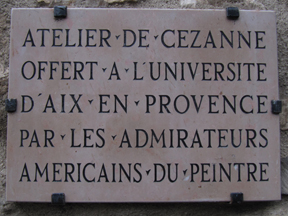
In March I finally had the opportunity to visit Paul Cézanne’s studio located in the provincial town of Aix-en-Provence. He fled to his hometown of Aix when the vitriolic Parisian art critics denounced his work and refused to jury his paintings in the Paris Salon of the 1800’s. Considering how derisive the criticism was, it’s a wonder he retained the courage and desire to paint. The townspeople of Aix even left messages on his doorstep at one point, requesting he leave Aix as he was “dishonoring” the town.
Now you can’t walk one block without seeing a restaurant or shop with his name on it. There are even bronze ‘C’s on the sidewalk to walk in his footsteps. Cézanne is big business for Aix now.

I must admit, I didn’t fully appreciate Cézanne’s work until I had to copy his still-life paintings in college. I then began to understand the varied perspectives in his work and the humble beginnings of cubist thought. Think of it. If Georges Braque had not studied Cézanne’s paintings while sharing a studio with Picasso, Cubism may have had quite a delayed start. I personally like the fact Cézanne isolated himself in Provence and painted what he wanted to, not pandering to the desires of critics and the fickle public.
Cézanne built his studio on the Chemin des Lauves in 1902. When he died in 1906, his son inherited the building and subsequently sold it to Marcel Provence. Provence wanted to preserve Cézanne’s heritage and when he died in 1951, the studio was going to be razed by developers. Two Americans, James Lord and John Rewald created the “Cézanne Memorial Committee” and 114 American donors contributed a total of 7,500,000 francs to save the studio. I don’t understand why the French government didn’t intervene. In fact, there are only two Cézanne paintings in all of Aix, at the Musée Granet.

Before my husband and I climbed the stairs to the dusty but well-preserved studio we were told photographs were strictly forbidden. Why? I have no idea save for the fact the city of Aix (which nows owns the studio) wants to make a profit on the poor quality studio postcards in the gift shop. The studio is large with two huge picture windows and Cézanne’s objets d’art that he used for his many still-lifes are strewn around the room. One of the enormous windows used to have an unobstructed view of Mont Sainte Victoire but tall gnarly trees now surround the studio. The room is very carefully arranged to make you think Cézanne has left to paint plein-air and will return at any time. Eerie but effective.

Before I left the room I detected his painting smocks in a small corner. Yes, the Master’s clothing replete with thick splotches of oil paint. I then did what any entitled American would do when they feel their countrymen saved a foreign national treasure. I shut the volume off of my iPhone, opened up the Sneaky Pix app and furtively snapped a couple of photographs. Sneaky Pix makes it look like you are talking on the phone with a fake call screen but it snaps photos while you are pretending to talk on the phone.

After purchasing some over-priced souvenirs in the gift shop, we walked around the lush grounds. I thought how fortunate it was that two Americans took the initiative to save this piece of art history. Hopefully, he wouldn’t have minded my sneaky photos.











